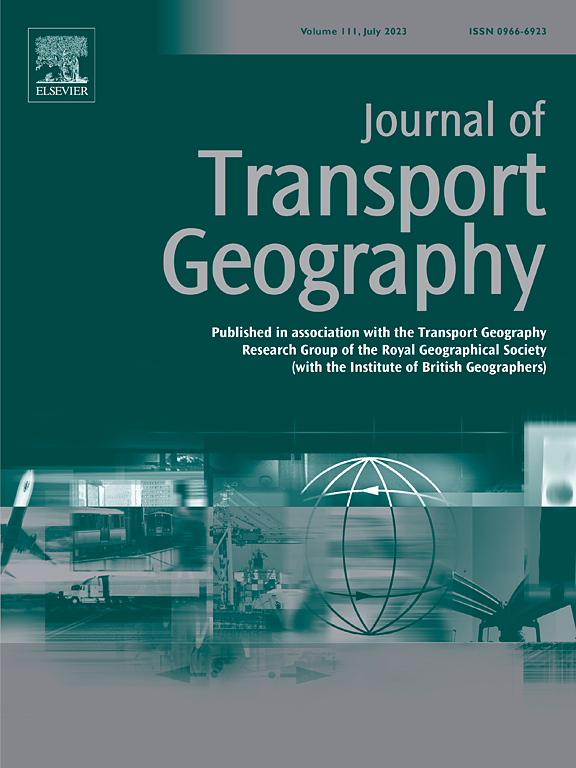模拟米兰女性在夜间的安全程度
IF 6.3
2区 工程技术
Q1 ECONOMICS
引用次数: 0
摘要
本文概述了米兰市女性夜间安全感知水平的数据分析和建模过程。这项研究工作包括STEP UP项目的最后阶段,该项目旨在利用地理空间数据分析方法评估米兰女性的步行性,共分为三个阶段:文献综述、数据收集和数据分析。本文提出的感知安全建模考虑了从开放数据和专有平台获取的广泛地理空间数据,量化了文献综述中确定的因素,以及Wher应用程序数据,这是一个关于女性在街头网络上自我披露的感知安全的众包数据集。这两组信息用于探索建筑环境与安全感知之间的关系。此外,本文还涵盖了筛选科学文献中出现的因素的过程,以及将概念转化为可操作的定量指标的过程。确定安全因素与感知安全之间关系的过程包括测试几个统计模型,最终导致地理加权回归(GWR)模型的实施,该模型被认为是最适合捕捉因素的空间异质性。项目结果显示,公共照明、公共交通和食品等三项指标具有统计学显著性。饮料,并包括局部R2和Beta系数值的空间变化,允许对特定地点的现象和复杂性进行推断。总体而言,本文提出的方法旨在弥合主观众包数据与城市特征数据之间的差距,提出一种分层方法来微调安全相关因素与地理空间数据之间的关联。它还提出了一种量化方法来模拟米兰女性夜间安全观念,最终有助于为更多的性别包容性交通规划和研究路线铺平道路。本文章由计算机程序翻译,如有差异,请以英文原文为准。
Modeling women's perceived level of safety at night in Milan
This article outlines the data analysis and modeling processes of the perceived level of safety for women at night time in the city of Milan. This research effort consists of the final phase of the STEP UP project, which was aimed to assess walkability for women in Milan using geospatial data analysis methods and involved three phases: literature review, data collection, and data analysis.
The modeling of perceived safety proposed in this paper takes into consideration a wide set of geospatial data, acquired from open data and proprietary platforms, quantifying factors identified in the literature review, and the Wher app data, a crowdsourced dataset of women's self-disclosed perceived safety on the street network. These two sets of information are used to explore the relationship between the built environment and safety perception. Moreover, this article covers the processes of filtering the factors emerged from scientific literature, and the translation from concepts into operationalizable quantitative indicators. The process of identifying the relations between the safety factors and the perceived safety consisted in testing several statistical models, ultimately leading to the implementation of a Geographically Weighted Regression (GWR) model, which appeared as the most suitable for capturing the spatial heterogeneity of the factors.
The results of the project showed the presence of three statistically significant indicators, namely Public Lighting, Public Transport, and Food & Beverage, and include the spatial variation of Local R2 and Beta coefficient values, allowing for the inference of site-specific phenomena and complexities. Overall, the approach proposed in this article aims to bridge the gap between subjective crowdsourced data and city characteristics data, proposing a layered methodology to fine-tune the association between factors relevant to safety and geospatial data. It also proposed a quantitative approach to model the nighttime safety perception of women in Milan, ultimately contributing to the overarching goal of paving the way for additional gender-inclusive mobility planning and research routes.
求助全文
通过发布文献求助,成功后即可免费获取论文全文。
去求助
来源期刊

Journal of Transport Geography
Multiple-
CiteScore
11.50
自引率
11.50%
发文量
197
期刊介绍:
A major resurgence has occurred in transport geography in the wake of political and policy changes, huge transport infrastructure projects and responses to urban traffic congestion. The Journal of Transport Geography provides a central focus for developments in this rapidly expanding sub-discipline.
 求助内容:
求助内容: 应助结果提醒方式:
应助结果提醒方式:


